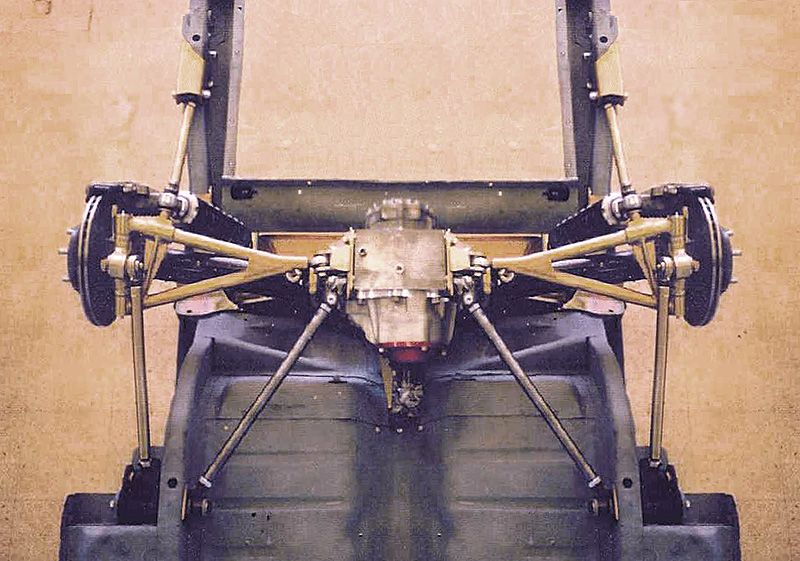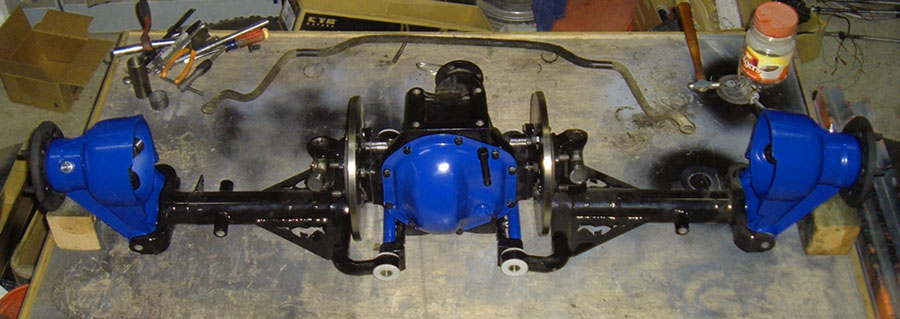

 |
 |
 |
 |
 |
You are not logged in. Would you like to login?
![]() Offline
Offline
Ok, I talked to a few of you a while back about optimizing a not optimal suspension. Just to freshen up... Long story short for the guys who don't remember or new people interested, I'm attempting to take down the second generation MR2 1/4 mile record. The bottle neck has proven to be the chassis. The suspension is far from ideal, but I have to keep "factory style" and use factory mounting points in order to be legal for any class that I would hope to be competitive.
This is factory stock rear suspension.
The factory design is incredibly basic (especially considering the cost of these cars when they were new) It consists of a strut, a lateral arm from the x-member to the lower ball joint, a longitudinal arm that intersects the lateral though a bushing and a toe control arm on the back side.
I'm working with a trusted MR2 community fabricator to help make a complete replacement suspension. His current iteration of chromoly suspension is just factory geometry with all solid heim joints and already holds the 1/4 mile record in a different car that no longer exists. We are trying to be more ambitious with my car and we want to play around with anti squat percentages and the forward instant center in relationship to CG. Neither him nor I are suspension engineers and it's hard to find good info for drag racing on an unpopular suspension type.
Here is his current design. !MKII Tubular Control Arms/ccly
The longer arm is the fore/aft arm and the shorter arm is the lateral. The lateral arm holds the lower ball joint in a tapered hole and the ball joint bolts to the bottom of the upright (knuckle. whatever you want to call it). You can see in the picture that he eliminates the intersection bushing and solidly brackets the arms together. This brings up my first question. Does it matter or not if there is any articulation at that point? It seems to me that the suspension is more or less acting as a big a-arm with the axis of movement being diagonal through the forward most joint and the inboard most joint. That brings me to my second question. How do I calculate instant center and anti squat with a setup like this. I understand that with a suspension, where the longitudinal arm is seperate in articulation (like an '88 fiero, for example ), you would draw a line forward through the two articulation points and beyond through the front of the car and where this would intersect with a line drawn from the top strut mount parallel to the ground would be the I/C, but does the same rule apply in my case where the forward arm is essentially one piece with the lateral arm or do I need to somehow calculate it based on the angle of the axis previously mentioned in my A-arm analogy?
We've thought about using balljoint spacers to change the angle of the forward arm and we've tossed around the idea of making a verticle bracket at the intersection point with multiple pick-up holes to adjust the angle of the forward arm. I'm not sure if changing the angle of the forward arm actually does anything though if everything is solidly together and the only pivoting is on the axis of the forward joint and the inboard joint. It seems like it would be better if the two arms were seperated and had individual pick-up points at the knuckle.
Help me out guys.
Last edited by Wolfenstein (4/29/2013 9:38 pm)
![]() Offline
Offline
What problem(s) are you having? Wheel Hop/Axle wrap? Too much squat? Not enough squat? Chassis not loading up? Constant wheel spin/no grip? Too much grip?
My initial thought with a short wheel base and rear wheel drive is you'd want the rear to squat a fair amount to increase traction.
Have you tried a progressive spring rate in your strut?
What angle is the strut rod at? I would expect a downward (to the rear) angle could help load up the chassis, increasing the downward pressure to the tires.
The worst idea I can come up with would be to induce bind in the articulation by lengthing the strut rod. This might reduce (a little) any axle wrap you have but would have the affect of pushing everything backwards, inducing uneeded stress.
If you are having axle wrap, the best mounting point for a Watts Link/arm might be where the strut mounts to the hub assembly.
Let us know what the problem is and we can throw ideas out until something sticks.
BTW, what is the 1/4 mile record?
![]() Offline
Offline

Thanks for the update Wolfenstein. I have always said build something adjustable as a novice suspension builder. It betters your odds for success!
Ralphy
![]() Offline
Offline
Ralphy wrote:
Thanks for the update Wolfenstein. I have always said build something adjustable as a novice suspension builder. It betters your odds for success!
Ralphy
That's what we're trying to do. I'm just trying to figure out how to build in the adjustability. Like I said we're gonna make a fully fabricated suspension, we just need some design inspiration for having adjustable geometry. We can't do anything with the body brackets as far as chopping them up goes. The body has to be stock. We thought about making an adjustable (multi hole) verticle bracket, but I'm not quite sure if that would even do anything regardless of the adjustment because it does nothing to change the imaginary hinge axis (dotted line in my picture)
This was my sketch of the idea
![]() Offline
Offline
303Radar wrote:
What problem(s) are you having? Wheel Hop/Axle wrap? Too much squat? Not enough squat? Chassis not loading up? Constant wheel spin/no grip? Too much grip?
My initial thought with a short wheel base and rear wheel drive is you'd want the rear to squat a fair amount to increase traction.
Have you tried a progressive spring rate in your strut?
What angle is the strut rod at? I would expect a downward (to the rear) angle could help load up the chassis, increasing the downward pressure to the tires.
The worst idea I can come up with would be to induce bind in the articulation by lengthing the strut rod. This might reduce (a little) any axle wrap you have but would have the affect of pushing everything backwards, inducing uneeded stress.
If you are having axle wrap, the best mounting point for a Watts Link/arm might be where the strut mounts to the hub assembly.
Let us know what the problem is and we can throw ideas out until something sticks.
BTW, what is the 1/4 mile record?
These cars hook up pretty well. 1.3 60-fts are not unheard of. They get away with it because of the rear weight bias. The problem is, I theorize, that this rear bias is not good for stability at higher speeds and/or high accellerative forces. I am doing everything I can to get a 50/50 is not more forward bias. MR2's have proven to be sketchy down track. Partially because of the rearward center of gravity, partially because of light steering at high speeds and partially because of the short wheelbase. I want to explore variations in loading the suspension arms in different ways. If you look at the side of the typical lowered MR2, the longitudinal arm is almost level with the ground. If I am supposed to figure instant center based off of this angle, it would probably be somewhere 80 ft in front of the car and when the car squats it would probably be underground as it then angles front down rear up. I am under the impression that having the instant center in front of the CG will try to rotate the car back and having it behind the CG will try to rotate the car forward. I have no idea what's going on when it goes underground. MR2's often do too much of a wheelie.
This is also assuming the IC is calculated off of only the forward arm. I have a nagging feeling that it might be based off of the imaginary dotted line in my picture regardless of the angle of the forward arm.
Also, while we are on the subject, I am under the impression that any squatting is taking weight off of the tires. Solid axle drag cars typically lift the rear on launch. This lifting's equal and opposite reaction is driving the tires downward. Like suddenly standing on a scale and watching the weight reading go up. Squatting does the opposite. Wheel hop is not an issue. Everything is solid, including the motor mounts. I'm not familiar with a watts link. I'm not sure what that is curing.
The current fastest MR2 time is 9.66 @ 144mph.
![]() Offline
Offline
Thanks for nice post